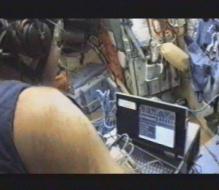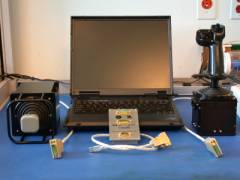System for Monitoring and Maintaining Mobile Servicing System Robotic Operators Performance (SMP)
Purpose
To develop and test an on-board system for the International Space Station (ISS) that will allow astronauts, who have been trained on the ground to operate the Mobile Servicing System (MSS), to measure and maintain their robotic operator skills in space.
Background
Canada's main contribution to the ISS is the MSS. The MSS consists of three parts including the Canadarm2, a robotic arm that is being used to assemble and maintain the ISS. The MSS is operated by astronauts and is used to move payloads, relocate astronauts performing spacewalks, capture free flying objects, and help maintain the station. Prior to their mission all ISS expedition crewmembers assigned to operate the MSS receive intensive training on the MSS ground training simulator at the Canadian Space Agency (CSA) followed by increment specific training on MSS simulators at the National Aeronautics and Space Administration (NASA).
Although astronauts are fully trained before their mission, the lack of practice between the last training session on the ground and the first use of the MSS in orbit, the stress of spaceflight and the physical challenges of the microgravity environment, may cause their skills to deteriorate in orbit. Previous experiments on the Russian space station MIR have shown that cosmonauts' (Russian astronauts) sensory motor skills degrade significantly after four to six weeks.
The objective of the System for Monitoring and Maintaining MSS Robotic Operators Performance (SMP) is to provide an on-board system that will allow astronauts to measure their skill level and if need be, use the system to recover their skills. This will ensure that astronauts keep practicing their skills and are able to operate the Canadarm2 when required.

Training on MIR. (Credit: S.P Korolev)
Project description
This project has two goals: first, to validate the SMP and second, to collect data on how cosmonauts' and astronauts' skills change in space. To validate the SMP, a prototype has been developed and was delivered to the Russian Service Module on the ISS in February 2003. Data will be collected on the how operator skills degrade and recover at different time intervals after training.
The SMP consists of a simulator of Canadarm2 and a free flying payload running on a laptop computer, as well as a pair of hand controllers. It also contains a software module that automatically measures, evaluates and provides feedback to the operator on his performance level.
To validate the SMP, subjects will be trained to perform specific robotic operator tasks, such as free flyer capture, until their skills reach a stable level. The results of the tests recorded during this training will be used as a baseline for comparison with future training sessions.
After the last training session the subjects will conduct performance tests, at different intervals, to assess how their skills have changed and perform skill recovery sessions to reach the stable level again. The control group will perform these tests on the ground whereas the experimental group will perform them in orbit.
Experiments with the control group are taking place at the S.P. Korolev Rocket and Space Corporation Energia, as well as at the CSA. The control group includes six cosmonauts who have already flown on the ISS or who have successfully completed MSS training, as well as six CSA instructors and engineers.
In orbit, the on-board experiment will be conducted during Expeditions 7, 8, 9 and 10. In total, the on-board experimental phase of the study will take two years or the equivalent of four missions.
The SMP will be integrated into a psycho-physiological system, designed by the German Aerospace Center (DLR). This integrated system will then be able to evaluate the mental workload of astronauts and their stress level when performing robotic operations.

Components of SMP
Benefits of SMP
- On the ground, SMP can be used as a pre-flight training simulator.
- SMP will better prepare astronauts and cosmonauts for MSS operations, such as the first capture of the free-flying Japanese module.
- The results of this project will provide valuable information to the Canadian training industry.
Background information
Free-flyer capture is the process of securing an object floating freely in space. It is one of the most difficult tasks to be performed by the robotic operator. Free-flyer capture requires use of complicated sensory and motor skills in a very limited amount of time. Cosmonauts or astronauts have approximately 90 seconds time to capture a drifting object. If they fail to do so, it may crash into the ISS and cause damage, or float away into open space.

Free flyer capture